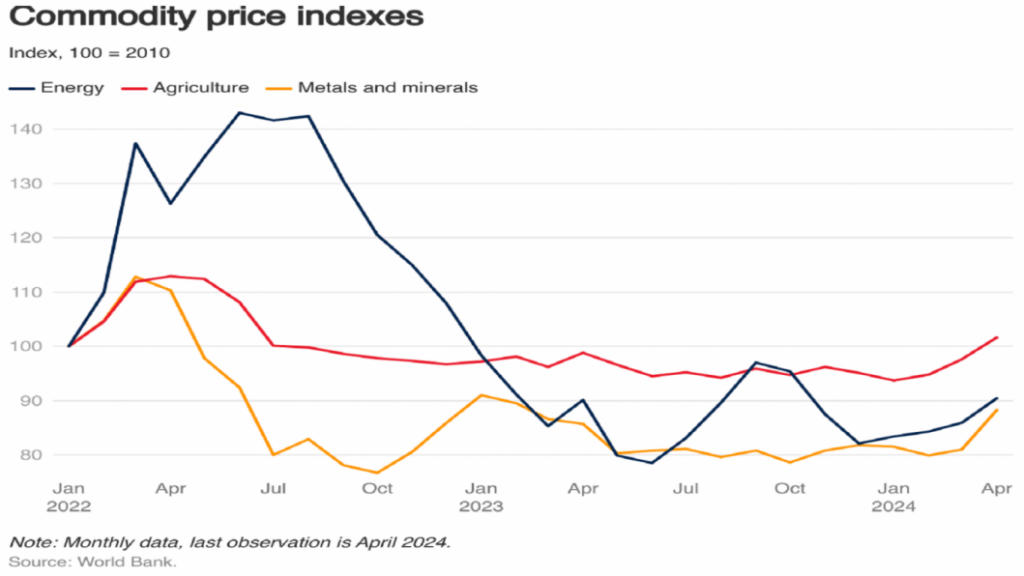The global commodities market is a pulse of the world economy, with raw materials like oil, metals, foodstuffs, and minerals forming the foundation of everything from technology to transportation. In 2024, as we look forward to a year marked by post-pandemic recovery, new energy policies, and emerging technologies, it’s clear that the commodities market is set for substantial shifts. This year, several factors are poised to drive these shifts, ranging from geopolitics and sustainability to advancements in technology and changing consumer preferences. In this article, we will delve into the key trends expected to shape the commodities market in 2024 and provide insights into the drivers and predictions that industry players and investors need to understand to navigate this complex landscape.

The Impact of Geopolitical Tensions
In 2024, geopolitical tensions remain a critical factor impacting commodity markets globally. Ongoing conflicts in resource-rich regions continue to disrupt supply chains, causing shifts in commodity availability and pricing. Countries like Russia and Ukraine, rich in natural gas and agricultural commodities, have been the focal points of geopolitical tension, leading to significant market fluctuations and re-routing of supply chains. Sanctions on key exporting nations, such as those placed on Russia for energy exports, have forced global markets to adapt quickly, with both buyers and suppliers seeking new partnerships to mitigate risks. Additionally, countries are increasingly diversifying their trade networks to avoid over-reliance on volatile regions, which is likely to impact how and from where commodities like oil, gas, and metals are sourced. As these shifts continue to unfold, they will have a profound influence on both the availability and cost of commodities in 2024.

Technological Advancements in Commodity Trading
Technology is transforming the commodities trading landscape in 2024, with artificial intelligence (AI), data analytics, and blockchain playing central roles in increasing efficiency, transparency, and risk mitigation. AI and data analytics are enabling more accurate demand forecasting, better risk assessment, and real-time pricing, offering traders the data they need to make more informed decisions. Blockchain technology is becoming increasingly popular as a tool for ensuring transparency in the supply chain, especially for high-value commodities such as precious metals and stones. By using blockchain, companies can authenticate the origins of their products, which is particularly valuable for consumers and companies focused on ethical sourcing. Additionally, automation in logistics is making it easier to reduce operational costs, streamline the supply chain, and increase resilience against disruptions. As these technologies become further embedded in the commodities market, they are expected to reshape how commodities are traded and valued globally.
Sustainability as a Key Market Driver
Sustainability is becoming one of the most significant drivers in the commodities market, with increasing emphasis on eco-friendly sourcing and sustainable practices. In 2024, consumers and businesses alike are pushing for sustainably sourced commodities, from organic agricultural products to responsibly mined minerals. Carbon pricing is another element that is making certain commodities, particularly fossil fuels, more expensive and less attractive as governments around the world set higher carbon taxes and encourage emissions trading. Renewable resources, such as lithium and cobalt, are also in high demand, given the push toward electric vehicles (EVs) and renewable energy technologies. As sustainability continues to shape consumer behavior and regulatory requirements, we can expect it to have a long-term impact on commodity demand, with increased focus on materials that support a greener and more sustainable future.
Energy Commodities: Oil, Gas, and Renewables
The energy commodities sector is facing a unique mix of challenges and opportunities in 2024. Oil and gas prices remain volatile due to OPEC+ decisions, regulatory changes, and ongoing geopolitical disruptions. As countries worldwide continue to strive for energy security and independence, the oil and gas markets will experience shifts that could affect global pricing. At the same time, the renewable energy sector is booming, with increased investment in solar, wind, and hydrogen power. This shift toward renewables is not only driven by environmental concerns but also by the desire for energy independence and cost savings in the long term. Additionally, natural gas and liquefied natural gas (LNG) are experiencing growing demand, particularly in the Asia-Pacific region, where countries like China and Japan are exploring these resources to reduce their carbon footprints. The interplay of traditional and renewable energy sources is expected to continue shaping the energy market throughout 2024, as the world transitions towards a more sustainable energy future.
Agricultural Commodities: Food Security and Climate Change
Agricultural commodities are among the most vulnerable to climate change, and 2024 is set to be another challenging year as extreme weather events continue to affect crop yields. From droughts in North America to flooding in Asia, climate change is having a direct impact on food production, which in turn drives up prices and creates concerns about food security worldwide. Countries and businesses alike are investing in innovative agricultural technologies, such as precision farming and vertical farming, to help mitigate these impacts. However, the challenge remains significant as the global population continues to grow and demand for food rises. Food security concerns, especially in regions heavily affected by climate disruptions, are likely to drive up the prices of grains, vegetables, and livestock. This dynamic highlights the need for sustainable practices in agriculture to ensure a stable food supply in the coming years.
Industrial Metals and Minerals
The demand for industrial metals and minerals is rising sharply, largely driven by the renewable energy and electric vehicle (EV) markets. Lithium, cobalt, and nickel, essential for battery production, are experiencing surging demand as the world embraces electric vehicles and other renewable energy technologies. At the same time, China continues to play a dominant role in the global metals market, both as a producer and as a major consumer. This dominance gives China considerable influence over pricing and availability, which can create challenges for countries and companies that rely on these metals for manufacturing. Moreover, there is an increasing focus on recycling and creating a circular economy for metals to help reduce dependence on newly mined resources. This shift toward sustainability in the metals sector is expected to have a long-lasting impact on supply chains and pricing in 2024 and beyond.
Precious Metals: A Safe Haven in Uncertain Times
Precious metals, such as gold and silver, are expected to remain popular investment choices in 2024, especially in times of economic uncertainty. Gold, in particular, continues to serve as a reliable hedge against inflation, which remains a concern for investors globally. Silver, with its dual role as both an industrial metal and a store of value, is also seeing increased demand, especially with its use in green technologies like solar panels. However, the supply of precious metals is constrained by limited new discoveries, and many mining companies face regulatory and environmental challenges. These factors are likely to drive up prices for gold, silver, and other precious metals as investors turn to these commodities for stability and growth potential.
Logistics and Transportation in Commodities
Logistics and transportation are essential components of the commodities market, and both are evolving rapidly in response to new challenges. Global freight rates are projected to fluctuate in 2024, influenced by factors such as fuel costs, demand for commodities, and carrier availability. Additionally, countries and companies are investing heavily in infrastructure, particularly in key markets like Africa and Asia, to improve logistics networks and facilitate smoother trade flows. There is also a push toward decarbonizing the transportation sector, which is leading to the development of greener shipping methods. This shift has cost implications for companies that rely on traditional shipping, but it also presents new opportunities for businesses that can adapt to these sustainable transportation models.
Financial and Investment Trends in Commodities
Commodities are becoming increasingly attractive to investors, with commodity-focused ETFs gaining popularity as a means to hedge against inflation and diversify portfolios. In 2024, private equity firms are also entering the commodity markets, bringing in new capital and reshaping investment flows. Central banks, too, play a significant role in the commodities market, particularly with their interest in gold reserves as a hedge against currency volatility. This growing interest from both institutional and retail investors is likely to have a stabilizing effect on certain commodities, particularly precious metals. The focus on commodities as a stable investment is expected to continue as global markets remain volatile and inflationary pressures persist.
Predictions and Outlook for 2024
As we look ahead to the remainder of 2024, several predictions and outlooks emerge. Commodity prices are expected to fluctuate based on geopolitical tensions, climate change, and technological advancements. Emerging markets, particularly in Asia and Africa, are likely to drive demand for industrial and agricultural commodities, while sustainability and regulatory changes will influence energy markets and the popularity of renewable resources. Additionally, the potential for unforeseen “black swan” events, such as natural disasters or sudden economic downturns, remains a reality, underscoring the need for companies to stay agile and adaptable.
The commodities market in 2024 is shaped by a complex array of factors, from geopolitical dynamics and technological advances to sustainability efforts and changing consumer preferences. As we move forward, businesses, investors, and governments must navigate this evolving landscape with care and adaptability. While challenges undoubtedly lie ahead, the opportunities for growth, innovation, and investment in sustainable commodities are abundant. The key will be to remain vigilant and responsive to these trends, ensuring that the global commodities market can support a stable, resilient, and sustainable global economy.



